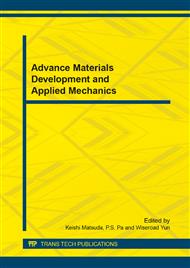[1]
S. Das, The cost of automotive polymer composites: a review and assessment of DOE's lightweight materials composites research, Oak Ridge, TN: Oak Ridge National Lab., 2001, pp.3-11.
DOI: 10.2172/10118077
Google Scholar
[2]
T. Gaensicke and M. Goede, Die Technische Motivation, in Leichtbau in der Fahrzeugtechnik, Wiesbaden, Springer Vieweg, 2013, pp.31-42. p.3.
DOI: 10.1007/978-3-8348-2110-2_2
Google Scholar
[3]
G. Ellenrieder, T. Gaensicke, M. Goede and H. G. Herrmann, Die Leichtbaustrategien, in Leichtbau in der Fahrzeugtechnik, Wiesbaden, Springer Vieweg, 2013, pp.43-118.
DOI: 10.1007/978-3-8348-2110-2_3
Google Scholar
[4]
C. Koffler and K. Rohde-Brandenburger, On the calculation of fuel savings through lightweight design in automotive life cycle assessments, The International Journal of Life Cycle Assessment, vol. 15, no. 1, 2010, pp.128-135.
DOI: 10.1007/s11367-009-0127-z
Google Scholar
[5]
E. Fuchs, F. Field, R. Roth and R. Kirchain, Strategic materials selection in the automobile body: Economic opportunities for polymer composite design, Composites Science and Technology, vol. 68, no. 9, 2008. pp. (1989).
DOI: 10.1016/j.compscitech.2008.01.015
Google Scholar
[6]
W. Marsden and S. Warde, Data Management for Composite Materials, Cambridge, 2010, p.3.
Google Scholar
[7]
Y. Ng and J. Tomblin, NCAMP Standard Operating Procedures (SOP), 2010, pp.5-7.
Google Scholar
[8]
For more Information see: http: /www. niar. wichita. edu/agate.
Google Scholar
[9]
For more Information see: http: /www. matweb. com.
Google Scholar
[10]
For more Information see: http: /www. coe. montana. edu/composites.
Google Scholar


